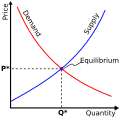
Back Gesetz vom abnehmenden Grenzertrag ALS قانون الإنتاجية المتناقصة Arabic Azalan gəlirlər qanunu Azerbaijani Llei de rendiments decreixents Catalan Zákon klesajících výnosů Czech Ertragsgesetz German Ley de los rendimientos decrecientes Spanish Errendimendu beherakorren lege Basque بازده نزولی Persian Vähenevän tuoton laki Finnish
This article needs additional citations for verification. (August 2011) |

| Part of the behavioral sciences |
| Economics |
|---|
 |
|
|
In economics, diminishing returns means the decrease in marginal (incremental) output of a production process as the amount of a single factor of production is incrementally increased, holding all other factors of production equal (ceteris paribus).[1] The law of diminishing returns (also known as the law of diminishing marginal productivity) states that in a productive process, if a factor of production continues to increase, while holding all other production factors constant, at some point a further incremental unit of input will return a lower amount of output.[2][3] The law of diminishing returns does not imply a decrease in overall production capabilities; rather, it defines a point on a production curve at which producing an additional unit of output will result in a lower profit. Under diminishing returns, output remains positive, but productivity and efficiency decrease.
The modern understanding of the law adds the dimension of holding other outputs equal, since a given process is understood to be able to produce co-products.[4] An example would be a factory increasing its saleable product, but also increasing its CO2 production, for the same input increase.[2] The law of diminishing returns is a fundamental principle of both micro and macro economics and it plays a central role in production theory.[5]
The concept of diminishing returns can be explained by considering other theories such as the concept of exponential growth.[6] It is commonly understood that growth will not continue to rise exponentially, rather it is subject to different forms of constraints such as limited availability of resources and capitalisation which can cause economic stagnation.[7] This example of production holds true to this common understanding as production is subject to the four factors of production which are land, labour, capital and enterprise.[8] These factors have the ability to influence economic growth and can eventually limit or inhibit continuous exponential growth.[9] Therefore, as a result of these constraints the production process will eventually reach a point of maximum yield on the production curve and this is where marginal output will stagnate and move towards zero.[10] Innovation in the form of technological advances or managerial progress can minimise or eliminate diminishing returns to restore productivity and efficiency and to generate profit.[11]
This idea can be understood outside of economics theory, for example, population. The population size on Earth is growing rapidly, but this will not continue forever (exponentially). Constraints such as resources will see the population growth stagnate at some point and begin to decline.[6] Similarly, it will begin to decline towards zero but not actually become a negative value, the same idea as in the diminishing rate of return inevitable to the production process.

- ^ "Diminishing Returns". Encyclopaedia Britannica. 2017-12-27. Retrieved 2024-08-15.
- ^ a b Samuelson, Paul A.; Nordhaus, William D. (2001). Microeconomics (17th ed.). McGraw-Hill. p. 110. ISBN 0071180664.
- ^ Erickson, K.H. (2014-09-06). Economics: A Simple Introduction. CreateSpace Independent Publishing Platform. p. 44. ISBN 978-1501077173.
- ^ Cite error: The named reference
:0was invoked but never defined (see the help page). - ^ Encyclopædia Britannica. Encyclopædia Britannica, Inc. 28 Nov 2023. ISBN 9781593392925.
- ^ a b "Exponential growth & logistic growth (article)". Khan Academy. Retrieved 2021-04-19.
- ^ "What Is Stagflation, What Causes It, and Why Is It Bad?". Investopedia. Retrieved 2023-04-23.
- ^ "What are the Factors of Production". www.stlouisfed.org. Retrieved 2023-04-23.
- ^ "What is Production? | Microeconomics". courses.lumenlearning.com. Retrieved 2021-04-19.
- ^ Pichère, Pierre (2015-09-02). The Law of Diminishing Returns: Understand the fundamentals of economic productivity. 50Minutes.com. p. 17. ISBN 978-2806270092.
- ^ "Knowledge, Technology and Complexity in Economic Growth". rcc.harvard.edu. Retrieved 2023-04-23.
© MMXXIII Rich X Search. We shall prevail. All rights reserved. Rich X Search